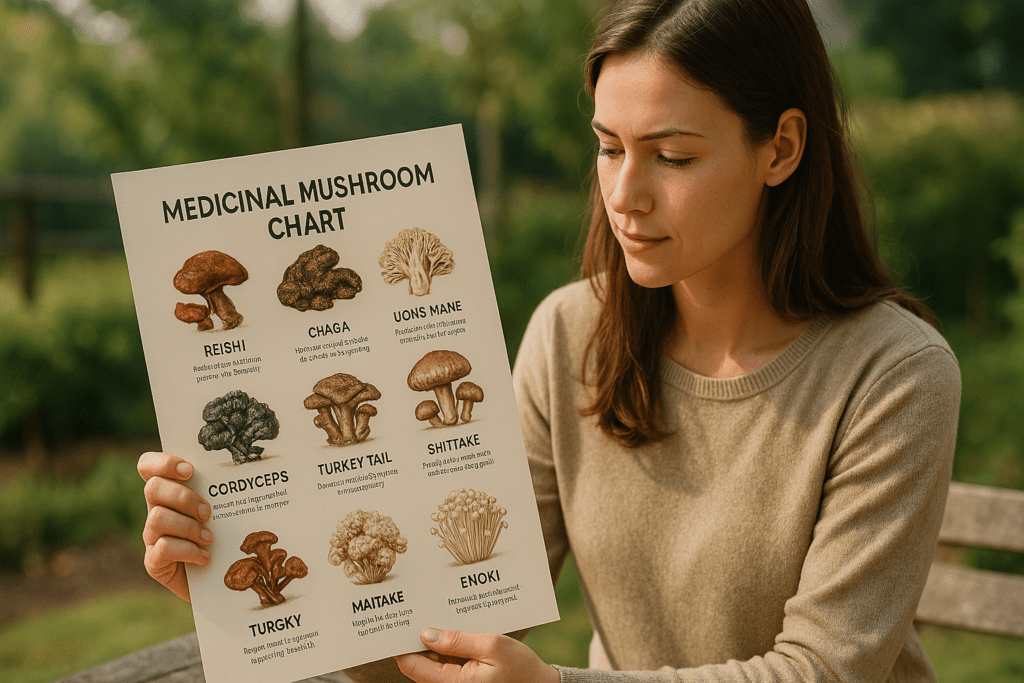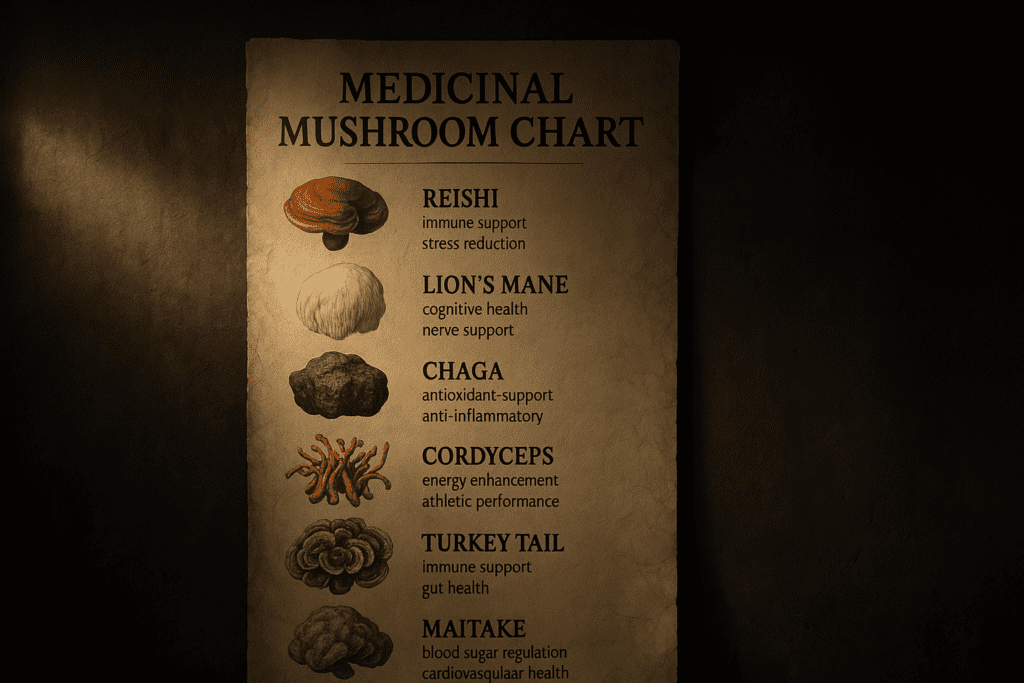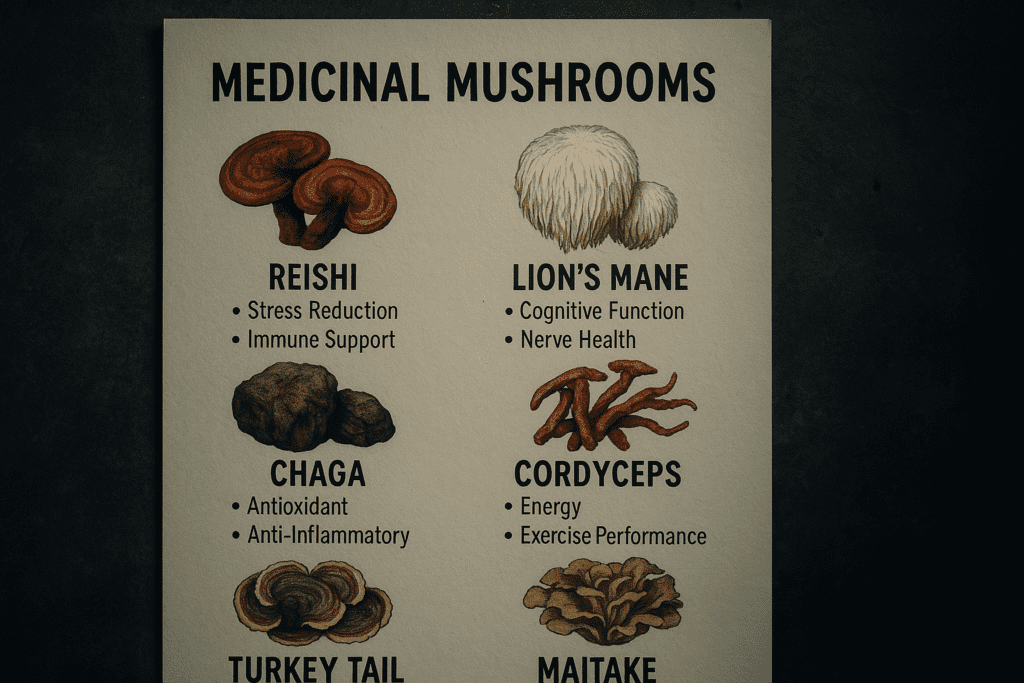In recent years, mushrooms have emerged from the forest floor to find a prominent place in both scientific research and modern wellness practices. Far beyond their culinary appeal, certain fungi possess therapeutic properties that have captivated the attention of mycologists, naturopathic doctors, and health-conscious consumers alike. As evidence accumulates, so does public interest in understanding the true value of these fascinating organisms. This article explores the most compelling aspects of medicinal mushrooms, presents a detailed medicinal mushroom chart, and offers a comprehensive look into the different types of mushrooms and their benefits. From boosting cognitive clarity to supporting immune function, the medicinal fungi list has something for nearly every aspect of human health.
You may also like: How Lion’s Mane Supplements May Support ADHD and Cognitive Clarity: What Science Says About Lions Mane for Focus and Brain Health
Understanding Medicinal Mushrooms: What Sets Them Apart
Not all mushrooms are created equal. While some species are prized for their rich flavors or culinary versatility, medicinal mushrooms are specifically valued for their bioactive compounds. These include polysaccharides like beta-glucans, triterpenoids, lectins, and other constituents that exert immunomodulatory, neuroprotective, antioxidant, and anti-inflammatory effects. Unlike synthetic pharmaceuticals that often target a single symptom or biochemical pathway, medicinal mushrooms interact with the body in a synergistic and holistic way. This multifaceted approach is what gives them such widespread appeal in functional medicine.
The term “medicinal mushroom chart” is often used to categorize these fungi based on their therapeutic properties, traditional uses, and biochemical profiles. A well-organized medicinal mushroom chart helps researchers, healthcare providers, and consumers alike to navigate the diverse applications of these fungi. It allows for comparison between mushroom types and benefits, offering an accessible overview for those seeking to understand their potential health-promoting uses.
A Historical Perspective on Medicinal Fungi
Medicinal fungi are not a modern discovery. In fact, their use dates back thousands of years across various ancient healing systems. Traditional Chinese Medicine (TCM) has long revered mushrooms like Reishi (Ganoderma lucidum) and Cordyceps for their role in promoting vitality, balance, and longevity. Similarly, Ayurvedic practices have acknowledged the healing power of fungi in managing stress and inflammation. Indigenous cultures across Siberia, North America, and Northern Europe also incorporated mushroom remedies into their spiritual and physical healing ceremonies.
These ancient traditions laid the groundwork for contemporary interest in mushroom-based wellness. As scientific tools evolved, researchers began isolating and studying the unique compounds responsible for these effects, confirming what traditional knowledge had long embraced. The continuity between historical usage and modern validation gives medicinal mushrooms a rare credibility in both integrative and evidence-based health communities.

Decoding the Medicinal Mushroom Chart
A high-quality medicinal mushroom chart typically includes detailed information on species names, active compounds, physiological effects, and suggested applications. For instance, Lion’s Mane (Hericium erinaceus) is widely known for its potential to enhance cognitive function and stimulate nerve growth factor (NGF), which is crucial for brain plasticity. Reishi, meanwhile, is often featured for its adaptogenic qualities, which help the body respond more effectively to stress. Turkey Tail (Trametes versicolor) is another entry that frequently appears due to its polysaccharide-K (PSK) content, shown in some studies to support immune function and even adjunct cancer care.
By using a medicinal mushroom chart, one can quickly assess how different fungi contribute to various aspects of health. It also offers a scientific framework for understanding the mechanisms behind each mushroom’s effects. Whether you are a clinician looking to recommend specific fungi for immune support or a health enthusiast curating your supplement routine, a comprehensive chart can be an indispensable tool.
The Medicinal Fungi List: A Taxonomy of Therapeutic Powerhouses
The growing medicinal fungi list continues to expand as new species are researched and more benefits are discovered. Some of the most well-known mushrooms on this list include Lion’s Mane, Reishi, Cordyceps, Turkey Tail, Shiitake, Maitake, and Chaga. Each has a distinct chemical profile and a unique set of applications. For example, Cordyceps militaris has garnered attention for its ability to support oxygen uptake and enhance athletic performance, making it popular among endurance athletes and biohackers alike.
Shiitake (Lentinula edodes) and Maitake (Grifola frondosa) are not only culinary staples but also rich in lentinan and D-fraction compounds, respectively, both of which have shown immune-enhancing and antitumor properties in preliminary studies. Chaga (Inonotus obliquus), a birch-dwelling fungus, has been widely studied for its high antioxidant capacity and potential to stabilize blood sugar levels. The ongoing research into these mushrooms and others continues to deepen our understanding of how fungi can be harnessed for preventative and therapeutic purposes.
Types of Mushroom Supplements and Their Benefits
The variety of mushroom types and benefits has inspired a proliferation of supplement formats designed to suit different preferences and lifestyles. These include capsules, powders, tinctures, teas, and even functional beverages infused with mushroom extracts. Each form has its own absorption rate, bioavailability, and convenience factor. For example, tinctures may offer faster absorption due to their alcohol base, while powders are ideal for adding to smoothies, coffee, or cooking recipes.
When choosing among different types of mushroom supplements, it is crucial to consider the method of extraction. Hot water and dual extraction (using both water and alcohol) processes are particularly important for making the most of the mushroom’s bioactive compounds. Beta-glucans, for instance, are water-soluble and best extracted through hot water, whereas triterpenes found in Reishi require alcohol extraction. Understanding these nuances can dramatically impact the effectiveness of a supplement.
Quality also plays a pivotal role in the efficacy of mushroom supplements. Products made from mycelium grown on grain may contain less of the beneficial compounds found in fruiting bodies, which are the reproductive structures of the fungus and often considered the most potent source of medicinal activity. Always look for brands that disclose whether they use fruiting bodies, mycelium, or both, and whether their products are third-party tested for purity and potency.
The Science Behind Mushroom Types and Benefits
The therapeutic potential of mushrooms lies in their complex chemical matrices. These organisms produce an array of secondary metabolites that interact with human physiology in nuanced ways. Among the most extensively studied are beta-glucans, which modulate the immune system by activating macrophages, natural killer cells, and dendritic cells. This action can enhance the body’s ability to fight infections and may even support anti-tumor immunity in specific contexts.
Neuroprotective effects are another promising area of research, especially with Lion’s Mane mushrooms. Preclinical studies suggest that hericenones and erinacines—two compounds found in Lion’s Mane—stimulate the production of nerve growth factor, a protein essential for maintaining, repairing, and regenerating neurons. This has significant implications for neurodegenerative diseases, cognitive decline, and overall brain health.
Antioxidant and anti-inflammatory properties are yet another reason mushrooms are being explored for their role in chronic disease prevention. Compounds such as ergothioneine, found in various mushroom species, act as cytoprotective agents that help cells maintain redox balance. These properties make mushrooms attractive candidates for mitigating oxidative stress-related conditions, such as cardiovascular disease, diabetes, and even aging itself.
Applications in Integrative and Preventive Medicine
Given the breadth of research supporting the medicinal fungi list, many healthcare practitioners are now integrating these mushrooms into treatment protocols. Integrative medicine, which combines conventional treatments with evidence-based complementary therapies, often includes mushroom supplements for their adaptogenic, anti-inflammatory, and immunomodulatory effects. In oncology, for example, Turkey Tail has been used in conjunction with chemotherapy to support immune resilience and improve quality of life.
Preventive medicine is another domain where mushroom types and benefits are especially relevant. Regular use of medicinal mushrooms may help reduce the risk of chronic conditions by modulating stress responses, lowering inflammation, and enhancing metabolic health. The cumulative effect of these benefits contributes to overall vitality and longevity, aligning well with holistic wellness philosophies that emphasize proactive care rather than reactive treatment.
The Role of Mushrooms in Brain Health and Cognitive Enhancement
One of the most exciting frontiers in the study of medicinal mushrooms is their potential impact on brain health. Cognitive decline, neurodegeneration, and mental fatigue are growing public health concerns, particularly as populations age. Lion’s Mane has gained substantial interest for its ability to promote neurogenesis and protect against neuronal damage. Studies on animal models have shown improvements in memory, learning, and mood following supplementation.
While more human studies are needed to establish definitive clinical recommendations, anecdotal reports and preliminary trials suggest that medicinal mushroom supplements may play a valuable role in supporting mental clarity, focus, and even creativity. As part of a broader nootropic regimen, they offer a natural complement to synthetic cognitive enhancers, often with fewer side effects. This positions mushrooms as a promising tool for individuals seeking to maintain cognitive agility well into their later years.
Exploring the Synergy Between Mushroom Types and Modern Health Trends
As interest in natural health products continues to grow, the synergy between different types of mushrooms and their benefits is increasingly appreciated. Rather than relying on a single mushroom species, many supplement formulations now combine several varieties to create a balanced and synergistic effect. For example, a blend of Reishi, Lion’s Mane, and Cordyceps might support stress reduction, cognitive enhancement, and physical endurance all at once.
This comprehensive approach mirrors the principles of adaptogenic stacking, where various herbs and fungi are combined to address multiple physiological systems. It also aligns with consumer demand for multifunctional wellness solutions that offer convenience without compromising effectiveness. These advanced formulations reflect the evolving sophistication of the mushroom supplement market and offer promising avenues for personalized health optimization.

Frequently Asked Questions (FAQ): Medicinal Mushroom Chart and Health Benefits
1. How do I determine which mushroom supplement is right for my specific health needs?
Selecting from the different types of mushrooms and their benefits requires more than simply choosing the most popular variety. Your personal health goals should guide your decision. For cognitive support, Lion’s Mane is often the preferred choice due to its neurotrophic properties, while Reishi may be better suited for stress resilience and immune modulation. A well-organized medicinal mushroom chart can help identify which species align with your needs by cross-referencing biological activity and traditional applications. Consulting a practitioner who understands the medicinal fungi list can further personalize your supplement choices for optimal results.
2. Are there any synergistic benefits when combining multiple mushroom species?
Absolutely, combining mushroom species can create a synergistic effect that amplifies overall wellness. Many integrative health practitioners formulate blends that include Cordyceps for energy, Reishi for stress relief, and Turkey Tail for immune balance. These mixtures reflect an advanced understanding of mushroom types and benefits, recognizing that each species targets different physiological systems. When reviewing the medicinal mushroom chart, look for combinations with complementary effects to maximize therapeutic potential. The types of mushroom supplements that include multi-species blends are often tailored for broader health outcomes.
3. How should I interpret product labels when evaluating mushroom supplements?
Labels can be confusing without background knowledge. One of the most important distinctions is whether a product contains mycelium, fruiting body, or both. The fruiting body is typically richer in bioactive compounds, while mycelium grown on grain may dilute potency. Understanding this helps you evaluate the quality among different types of mushroom supplements. Additionally, refer to a trusted medicinal mushroom chart to verify that the species listed align with the desired health benefits, and check for third-party testing to ensure purity and active compound content.
4. What emerging research areas are expanding the medicinal fungi list?
Researchers are now exploring lesser-known species such as Agaricus blazei and Phellinus linteus for their anticancer and anti-inflammatory potential. The medicinal fungi list continues to grow as advances in genomics and metabolomics uncover new bioactive compounds. Studies are also investigating how environmental factors affect the therapeutic potency of fungi, such as altitude, substrate, and harvesting time. These developments will likely lead to more specialized mushroom types and benefits becoming available in targeted formulations. A dynamic medicinal mushroom chart is essential to stay current as the landscape evolves.
5. Are there potential interactions between mushroom supplements and prescription medications?
Yes, some mushroom species can interact with medications, particularly those affecting the immune system or blood clotting. For example, Reishi may potentiate the effects of anticoagulants, while Turkey Tail could influence immunotherapy outcomes. Understanding the types of mushroom supplements and their pharmacological activity is crucial for avoiding contraindications. If you are on medication, consult your healthcare provider and cross-check supplement profiles using a comprehensive medicinal mushroom chart. Personalized guidance ensures safety while optimizing the benefits of medicinal fungi.
6. How do mushroom supplements fit into functional and performance nutrition?
Athletes and biohackers are increasingly incorporating mushroom supplements into their routines for endurance, recovery, and mental focus. Cordyceps has gained popularity in pre-workout blends due to its role in enhancing cellular energy and oxygen utilization. Lion’s Mane is often paired with nootropic stacks to support learning and concentration. Understanding the medicinal fungi list helps tailor supplementation based on performance goals, and a well-researched medicinal mushroom chart can reveal overlooked options such as Chaga for antioxidant support during intense training. This integrative approach reflects the growing awareness of mushroom types and benefits in the sports nutrition world.
7. Can mushroom supplementation support emotional resilience and mental wellness?
Yes, several mushroom species demonstrate adaptogenic and mood-regulating properties. Reishi has a calming effect that can aid in emotional balance, while Lion’s Mane may help regulate mood through its neurotrophic influence on brain plasticity. This psychological benefit isn’t always highlighted in basic lists of mushroom types and benefits but is increasingly backed by clinical and anecdotal evidence. When exploring the medicinal mushroom chart for mental health applications, consider blends that address both physiological stress and neurological support. These dual-action formulas are growing in popularity among those seeking holistic mood enhancement.
8. What role do cultivation and extraction methods play in supplement efficacy?
The method of cultivation—including substrate, lighting, and harvesting practices—can significantly affect the concentration of beneficial compounds. For example, mushrooms grown on natural logs tend to have higher beta-glucan content than those cultivated on rice or oats. Similarly, extraction techniques such as hot water or dual extraction determine which bioactives are available in the final product. This information often isn’t clearly labeled, which is why referencing a reputable medicinal mushroom chart and understanding the types of mushroom supplements is so important. Higher-quality supplements will disclose these details to support informed consumer decisions.
9. How can consumers navigate misinformation and exaggerated health claims?
Not all information online about different types of mushrooms and their benefits is evidence-based. Some companies exaggerate claims or present incomplete data to market their products. To navigate this, consumers should rely on sources that prioritize EEAT principles—Experience, Expertise, Authoritativeness, and Trustworthiness. A scientifically vetted medicinal mushroom chart and a validated medicinal fungi list can help distinguish between genuine health support and marketing hyperbole. Look for products that cite clinical studies, use transparent labeling, and avoid sensational language.
10. What future trends are shaping the mushroom supplement industry?
Emerging trends include the development of personalized mushroom stacks based on genetic and microbiome profiles, as well as the incorporation of AI to tailor dosing regimens. There is also a growing interest in sustainable cultivation practices and ethical wild harvesting. The medicinal mushroom chart is expected to evolve in real time to reflect new discoveries and niche therapeutic uses. The types of mushroom supplements available will likely expand to include more targeted formulas for conditions such as metabolic syndrome, sleep disorders, and hormonal balance. These innovations will deepen our understanding of the medicinal fungi list and open up new possibilities for integrative health care.

Conclusion: Why the Medicinal Mushroom Chart Matters for Informed Wellness
In an age of information overload and wellness fads, having a clear, science-backed framework like the medicinal mushroom chart is more important than ever. This chart serves not just as a guide, but as a foundation for informed decision-making about how to incorporate medicinal fungi into daily life. With a well-structured medicinal fungi list and a deeper understanding of mushroom types and benefits, individuals can tailor their supplement choices to meet specific health goals, whether that’s boosting immunity, enhancing cognitive function, or improving metabolic balance.
As research continues to uncover new layers of fungal bioactivity, the importance of selecting the right types of mushroom supplements becomes increasingly clear. From extraction methods to fruiting body content, every detail matters in ensuring efficacy and safety. Ultimately, understanding the different types of mushrooms and their benefits empowers consumers to take control of their wellness journeys with confidence, curiosity, and scientific insight. At the intersection of tradition and innovation, medicinal mushrooms offer a timeless solution to modern health challenges, and the chart that maps their power is an essential compass in that journey.
Further Reading:
Functional Mushrooms: 7 Kinds and Their Unique Health Benefits
Medicinal Mushrooms | Definition, List & Importance
functional mushrooms, brain health supplements, immune-boosting fungi, adaptogenic herbs, herbal nootropics, natural stress relief, holistic wellness, anti-inflammatory foods, cognitive enhancers, plant-based medicine, superfood mushrooms, organic mushroom extracts, neuroprotective nutrients, traditional Chinese herbs, mind-body health, alternative healing, biohacking supplements, natural energy boosters, longevity nutrition, integrative health solutions
.Important Note: The information contained in this article is for general informational purposes only, and should not be construed as health or medical advice, nor is it intended to diagnose, prevent, treat, or cure any disease or health condition. Before embarking on any diet, fitness regimen, or program of nutritional supplementation, it is advisable to consult your healthcare professional in order to determine its safety and probable efficacy in terms of your individual state of health.
Regarding Nutritional Supplements Or Other Non-Prescription Health Products: If any nutritional supplements or other non-prescription health products are mentioned in the foregoing article, any claims or statements made about them have not been evaluated by the U.S. Food and Drug Administration, and such nutritional supplements or other health products are not intended to diagnose, treat, cure, or prevent any disease.


